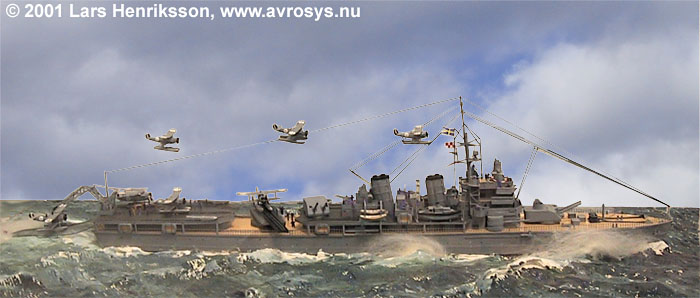|
|
||
|
S
9 - Hawker Osprey (1934-1947) |
||
|
|
Page 1 (2) |
|
|
|
||
 |
||
|
The
aircraft cruiser HMS Gotland, launched in 1934 and scrapped in 1960, was
the only aircraft carrier ever in the Swedish Navy. In fact, it served
as an aircraft cruiser only for nine years. In 1943-1944, the aircraft
deck was removed and the Gotland was rebuilt as an anti-aircraft
cruiser. In 1955, the armament was modernised and fire direction radar
installed. HMS Gotland was used for long cruises abroad with cadets
during the winters and to represent the Swedish Navy at other occasions.
The
Gotland had room for eleven aircraft type Hawker Osprey, but only six
were procured. The aircraft deck was placed over the quarterdeck. The
aircraft were stored on trolleys that went on rails. The were launched
by of a catapult, operated by compressed air. The aircraft had to land
in the water and be lifted aboard the ship by a crane. Test were also
made by a ”drag sail”, which was towed behind the ship. The landed
aircraft taxied up on the ”sail” and could now easier be lifted
aboard. But both methods had the great disadvantage that the ship had to
stop or at least slow down considerably, which of course could be
disastrous in a war situation. In practise, the aircraft started from
the Gotland and landed somewhere along the coast.
Hawker
Osprey, Swedish designation S 9,
were similar to the Hawker Hart (B
4), which was used by the Swedish Air Force as a dive bomber. The
six S9s were delivered in 1934-1935. They got the registration numbers
2401-2406. The main tasks of the two-seat Osprey was reconnaissance and
fire direction, but it could also be used as a fighter. The S 9 was
armed with one fixed and one moveable 8 mm machine-gun m/22.
The
S 9 was powered with a Bristol Mercury My VI engine, built on licence by
Nohab in Trollhättan. The nine-cylinder engine (in Britain manufactured
under the name ”Bristol Pegasus I”) delivered 600 hp. This engine
was also used in several other of the aircraft types of the Air Force.
The
S 9 was fitted with aluminium floats of Shorts make and had backward
foldable wings. Wheel landing gear were also provided. The fuselage was
made of steel- and aluminium piping, covered with canvas. The part
around the engine was covered with aluminium plating. The wings were
covered with ply and impregnated canvas. The observer/radio operator had
his seat turned backward.
After
their service as combat aircraft, three of
the Ospreys were rebuilt as target towing aircraft. Length: 9,64 m. Span: 11,28 m. MTOW: 2.450 kg. Max. speed: about 230 km/h.
Photo at top: # 2403 taking
off from HMS Gotland. Below: Model of HMS Gotland exhibited at Flygvapenmuseum (Swedish Air Force Museum). |
||
 |
||
 |
||
|
|
||
|
|
||
|
|
||
|
© Lars Henriksson |
|
Updated 2010-07-17 |